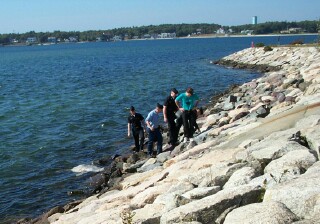|

Report
#1: Technical question & answer summary of meeting with submarine
pilot
written by MMA engineers:
3/C Holcroft
Mr. O'Brien
2/C Maguire
2/C Pike
3/C Sunde
UCCRTS technicians:
Bodio
Francis
Marconi
O'Brien
Young
Question: What was the most difficulty you might have with the Submarine?
Answer: Keeping it still (while doing delicate measurements).
Question: How often do they go out and sample?
Answer: 8 samples for a 5 hour dive on different sections (where) they take another
sample of the ocean (floor) crust.
Q: How deep does the vehicle operate?
A: Alvin has a (max) operating depth of 4,500 m.
Q: How much pressure can the mini sub handle?
A: 45,000 PSI (editor's note: Is this a typo? See question below.)
Q: What temperature is the water at the operating depth?
A: The water is consistently at about 2 C.
Q: A question of depth, pressure and temperature averages was also
asked.
A: ALVIN can dive to a maximum depth of 4500 meters and has an average 3000 m;
an average temperature of 2-3 degrees C until a volcanic area is entered.
The pressure is thousands of pounds per square inch. It seemed to be that
the numbers of tags that are placed could range from a couple to a couple dozen.
Q: What powers the sub ALVIN?
A: An electric motor which is powered by lead acid batteries and can travel
around 1.5 knots.
Q: What type of surfaces will the tags be placed?
A: Dr. Tivey passed around a couple of samples of the rocks that are to be
tagged and collected. what is usually on the surface is a glass like inch
thick coating over an iron rich extremely dense rough rock. The coating has
a texture of thick scales. This information is extremely important when
working with adhesives because the area to be glued will work better if it
is roughed to give the adhesive a bite to the object. The naturally rough
surface is a huge plus for our research. It was mentioned that the rock's
surface could be coated with a thin layer of settling sediment; however, it
could just be pushed off using the water.
Q: What are the salinity levels like at different levels?
A: The salinity of the water is most potent within the first 200 ft of water
column and doesn't really change that much thereafter. When ALVIN gets to
an area of volcanic activity there is a possibility the releasing heat to
heat the surrounding water to boiling (under great pressure--it is about 500
degrees C). This is one area where the salinity is greatly increased.
Other important information was that the basket can hold 500 lbs,
3'x4', the arm can lift 200 lbs with a 6' reach, opening the claw hand
about 8''-9''.
The Questions I had were about how Alvin (1) Carried its various equipment
down, (2) The dexterity of the arms, and how they worked together, and (3)
what type of things would be being marked.
For question (1) I found that Alvin had to fit what it was to use in a basket
located on the front skid. For (2) I found that the arms were very controllable,
limited by the Pilot mainly. Also that the left arm was much more precise,
and that the arms really do not work together. So whatever device we
come up with will really need to be done with one arm. And as for (3), I saw
that a wide variety of objects would be being collected. So, the method that
we come up with will have to be very versatile.
Q: How long are the manipulators on ALVIN?
A: Each manipulator is about nine feet long, and can lift 200 pounds
each. The right manipulator has six joints, and is hydraulically operated.
the left manipulator has seven joints, and is computer controlled, and is
the more versatile of the two.
What is the geometry of movment of ALVIN's Hydralic Manipulators?
I found the answer in the WHOI web site. The manipulator
has six degrees of movement: hand can open and close, wrist can pitch and
rotate, elbow pitch and shoulder pitch and yaw. The starboard arm max
extension is 69" with a lifting capacity of 100 lbs. Th port arm actually
has the same movement capeability as starboard but the wrist also has
yaw. It can lift 150 lbs with a max extension of 74". The wrist torque is
rated for 30 ft-lbs and a rotation rate of 65rpm. It is possible to have a
second wrist assembly put in place that has 15ft-lbs of torque and a
rotation rate of 130 rpm.
The hand of the manipulators are designed to grip instruments fitted
with a "T" fitting that is made from
1/2" diameter 316 stainless steel, but advice from the ALVIN Group on this
is a must. I have the diagrams of movement on the manipulator arms as well
as the diagrams for the sample basket.
Q: How do you identify or mark the current rock samples?
His answer: the arms of the robot attempt to etch or scratch a line into the
top surface of the rock.
Q:If you were to be using different tools such as a chisel, then needed to
switch to a hammer, how are these tools held onto the sub? Are they
attached by laying them in a basket and just reaching in to retrieve them
or are the held onto the actual grappling arm of ALVIN?
A: The tools that are going to be needed for the dive are attached to the
sub before the dive takes place. They are held on by a lanyard so they will
not get lost if dropped by the arm. If the dive required various tools, all
of them are grouped together by a big elastic band. Once the tools are done
being used, they are left dangling down and hung from the lanyard.
|

